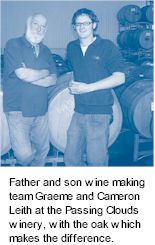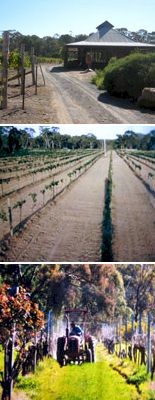


The story begins in 1973 when Graeme Leith and Sue Mackinnon great friends and partners decided that they wanted even more challenges in life than were possible for them in their careers as electrical contractor and journalist; Graeme was the electrical contractor. They wanted to brave the elements, face the challenges of the land, and like so many before them pursue the holy grail of the best wine in the world.

Working on the principle that enthusiasm triumphs over professionalism, the first vines were planted at Kingower by Sue Mackinnon, Graeme Leith, Anne and David Brown (who then wisely took up cheese making) in November 1973 by the headlights of the van from which they had driven from Melbourne after work. They didn’t want it to be dependent on pesticides or insecticides so they chose a site in a dry area north west of Bendigo on old gold diggings, where the soil had been dug over a hundred and twenty years before by goldminers.
They laid out the wires, measured the distance between the vines, dug the holes with shovels and planted 150 vines, initially shiraz and cabernet sauvignon to make a classic Aussie blend. There were also riesling vines planted, that Tom Lazar had left over from his last plantings at Virgin Hills, and which he had kindly donated. They then had some supper and drove back to Melbourne. They were younger, then.
After several years of nurturing their plantings, they experienced the first real Passing Clouds vintage, and released their inaugural wine. They were successful, and the first wine they showed at the Melbourne Wine Show, the 1982 shiraz cabernet won gold. Since then the vineyards produce has won numerous medals for magnificent wines, presently including not only the predominant Graeme’s Blend shiraz cabernet, but The Angel, a cabernet sauvignon merlot cab franc, some spectacular shirazes, and over the last few years the pinot noir made from Coldstream grapes.

White wines are made too, but Passing Clouds is famous for its reds, reds of great character, individuality and superb quality. As one wine writer said "I have a lot of sample bottles on my table at the end of the day, but whenever there’s Passing Clouds, it’s the one we drink with dinner!"
The first Passing Clouds, a glorious concentrated red had too little chemical input, no sulphur was added as a preservative and the wine had a very short life span. From then on all wines have had minimal sulphur additions to keep them alive and well, as Winemaker Graeme Leith accepted that the Romans had it right two thousand years ago when they burned sulphur in their amphorae. Unirrigated, ripe fruit, traditional methods of hand plunging in small fermenters and hand presses cranking down the cake late into the night was the formula for the next twenty years and many superb wines were produced.
Some more sophisticated wine making equipment has been added over the last ten years or so, including an air bag press. Today's Passing Clouds are as good or better than the Gold winning 1982 shiraz cabernet. Winemaker Graeme Leith has always enjoyed the challenge of different styles, different varieties. Passing Clouds now releases The Angel cabernet, three different shirazes, cabernet franc, grenache, Graeme’s Blend shiraz cabernet, chardonnay and sauvignon blanc and lately the highly regarded pinot noir, crafted from Coldstream fruit. The estate also makes the highly acclaimed Three Wise Men pinot at Kingower with fruit transported from Narre Warren East.
Generally speaking the best wines over the years have been made in dry seasons, the wetter seasons have produced weedier wines. All of the Passing Clouds reds are of exemplary quality and have the power to age gracefully, plus something special no other Bendigo district wines seem to have. According to many, what distinguishes Passing Clouds from other Bendigo wines, is a fleshy full bodied weight, an opulence and plushness that makes many other Bendigo reds seem skeletal by comparison.
